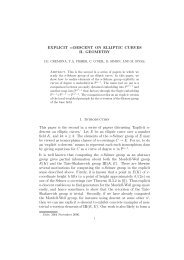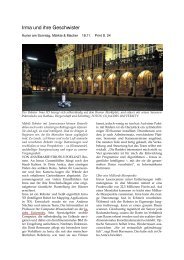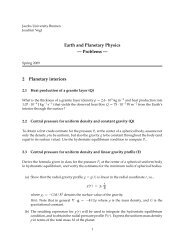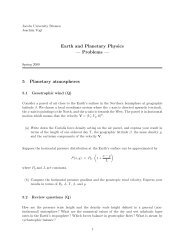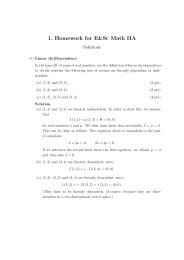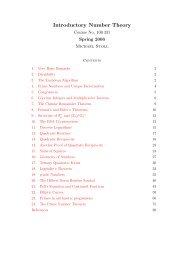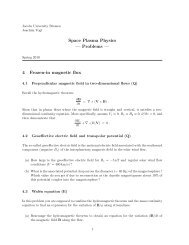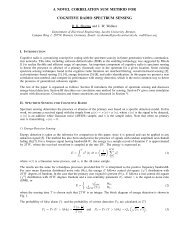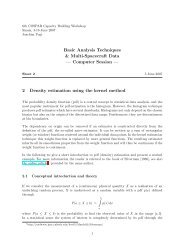Linear Algebra II (pdf, 500 kB)
Linear Algebra II (pdf, 500 kB)
Linear Algebra II (pdf, 500 kB)
Create successful ePaper yourself
Turn your PDF publications into a flip-book with our unique Google optimized e-Paper software.
10<br />
4.2. Remark. If U1 and U2 are linear subspaces of the vector space V, then V =<br />
U1 ⊕ U2 is equivalent to U1 and U2 being complementary subspaces.<br />
Next, we discuss the relation between endomorphisms of V and endomorphisms<br />
between the Ui.<br />
4.3. Lemma and Definition. Let V be a vector space with linear subspaces Ui<br />
(i ∈ I) such that V = <br />
i∈I Ui. For each i ∈ I, let fi : Ui → Ui be an endomorphism.<br />
Then there is a unique endomorphism f : V → V such that f|Ui = fi for<br />
all i ∈ I.<br />
We call f the direct sum of the fi and write f = <br />
i∈I fi.<br />
Proof. Let v ∈ V . Then we have v = <br />
i ui as above, therefore the only way<br />
to define f is by f(v) = <br />
i fi(ui). This proves uniqueness. Since the ui in the<br />
representation of v above are unique, f is a well-defined map, and it is clear that<br />
f is linear, so f is an endomorphism of V. <br />
4.4. Remark. If in the situation just described V is finite-dimensional and we<br />
choose a basis of V that is the union of bases of the Ui, then the matrix representing<br />
f relative to that basis will be a block diagonal matrix, where the diagonal<br />
blocks are the matrices representing the fi relative to the bases of the Ui.<br />
4.5. Lemma. Let V be a vector space with linear subspaces Ui (i ∈ I) such that<br />
V = <br />
i∈I Ui. Let f : V → V be an endomorphism. Then there are endomorphims<br />
fi : Ui → Ui for i ∈ I such that f = <br />
i∈I fi if and only if each Ui is invariant<br />
under f (or f-invariant), i.e., f(Ui) ⊂ Ui.<br />
Proof. If f = <br />
i fi, then fi = f|Ui , hence f(Ui) = f|Ui (Ui) = fi(Ui) ⊂ Ui.<br />
Conversely, suppose that f(Ui) ⊂ Ui. Then we can define fi : Ui → Ui to be the<br />
restriction of f to Ui; it is then clear that fi is an endomorphism of Ui and that<br />
f = <br />
i fi. <br />
We now come to a relation between splittings of f as a direct sum and the characteristic<br />
or minimal polynomial of f.<br />
4.6. Lemma. Let V be a vector space and f : V → V an endomorphism. Let<br />
p(x) = p1(x)p2(x) be a polynomial such that p(f) = 0 and such that p1(x) and p2(x)<br />
are coprime, i.e., there are polynomials a1(x) and a2(x) such that a1(x)p1(x) +<br />
a2(x)p2(x) = 1. Let Ui = ker pi(f) , for i = 1, 2. Then V = U1 ⊕ U2 and the Ui<br />
are f-invariant. In particular, f = f1 ⊕ f2, where fi = f|Ui .<br />
Proof. We first show that<br />
im p2(f) ⊂ U1 = ker p1(f) and im p1(f) ⊂ U2 = ker p2(f) .<br />
Let v ∈ im p2(f) , so v = p2(f) (u) for some u ∈ U. Then<br />
<br />
p1(f) (v) = p1(f) p2(f) <br />
(u) = p1(f)p2(f) (u) = p(f) (u) = 0 ,<br />
so im p2(f) ⊂ ker p1(f) ; the other statement is proved in the same way.<br />
Now we show that U1 ∩ U2 = {0}. So let v ∈ U1 ∩ U2. Then p1(f) (v) =<br />
p2(f) (v) = 0. Using<br />
idV = 1(f) = a1(x)p1(x) + a2(x)p2(x) (f) = a1(f) ◦ p1(f) + a2(f) ◦ p2(f) ,



